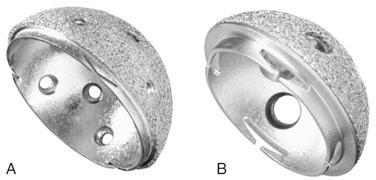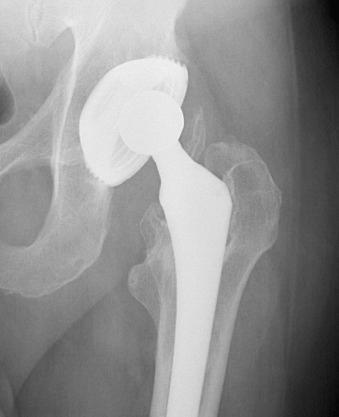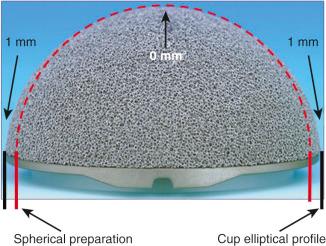Physical Address
304 North Cardinal St.
Dorchester Center, MA 02124
Requirements for cementless ingrowth include initial implant stability, appropriate pore size, adequate surface contact with host bone, and an implant material that is conducive to bone ingrowth. Titanium has been shown to be qualitatively and quantitatively superior to cobalt-chromium as an ingrowth material.
Several studies at more than 20 years’ follow-up show durable long-term fixation with titanium, hemispheric, cementless acetabular components inserted with screws.
The use of modularity, while improving intraoperative flexibility in optimizing hip stability and mechanics, has been associated with nonarticular (backside) surface wear. A secure locking mechanism and a polished inner surface of the shell seem to mitigate these problems.
The most common long-term modes of failure when standard polyethylene is used include wear of the bearing surface and associated osteolysis. More wear-resistant bearing surfaces, such as highly cross-linked polyethylene, may decrease the rate of reoperation related to articular surface wear and component loosening secondary to osteolysis.
Newer porous metal components offer the potential for increased bony ingrowth; however, clinical results at this time do not suggest a benefit over traditional porous ingrowth surfaces.
Cemented acetabular component fixation in total hip arthroplasty (THA) was introduced in the early 1960s by Sir John Charnley. Early results demonstrated favorable clinical outcomes, with radiographic loosening rates of less than 5%. The use of cement remained the major mode of acetabular component fixation until longer-term (> 10-year follow-up) results demonstrated rates of radiographic loosening as high as 60%. Improvements in cement technique throughout the 1970s and 1980s led to improved femoral component durability, but similar benefits were not recognized on the acetabular side. In addition, the surgical technique for cemented acetabular fixation is technically demanding and, even in expert hands, radiographic outcomes were not always ideal. Furthermore, the lack of liner modularity rendered few options for optimizing intraoperative stability. Based on these factors, interest mounted in a new approach to acetabular component fixation. Specifically, biologic fixation of acetabular components through insertion of a cementless device developed as an alternative method of reconstruction in the hope that a biologic bond between implant and host bone would provide greater long-term durability, along with a simpler, more reproducible surgical technique and greater intraoperative flexibility.
Cementless acetabular fixation brought about the advent of novel designs and cup geometries and the use of different implant materials in conjunction with various surface coatings that would lead to initial implant stability and long-term biologic fixation. Factors critical to obtaining adequate stability and biologic fixation were identified, and methods of cup insertion were developed. Radiographic and clinical evaluation at more than 20 years postoperatively have shown favorable results that have made hemispheric, porous-coated, cementless acetabular devices with or without adjunctive screw fixation the implant of choice in most North American centers for primary THA.
Requirements for bone ingrowth include biocompatibility of the surface material, an appropriate pore size, adequate surface contact with host bone, and initial stability during the incorporation process. Pilliar and associates demonstrated that excessive micromotion greater than 150 µm at the bone-implant interface resulted in fibrous tissue infiltration behind the acetabular component as opposed to bone ingrowth. Bobyn and colleagues determined that the optimal pore size for bone ingrowth to occur was between 100 µm and 400 µm. As a result of these findings, in the early 1980s, porous-coated hemispheric cups were introduced, including porous-coated anatomic (PCA, Howmedica, Rutherford, NJ), Harris-Galante (Zimmer, Warsaw, IN; Fig. 64.1 ), and anatomic medullary locking cups (AML, DePuy, Warsaw, IN).

Various different materials were initially used for manufacturing cementless acetabular components, including nonmetallic materials (such as all-polyethylene or all-ceramic components, which met with high failure rates, as there was no surface by which ingrowth could support long-term stability) and, more commonly, titanium or cobalt-chromium alloys. Both metal-based materials are biocompatible and are capable of supporting bone ingrowth. However, quantitatively, titanium has shown increased bone density, deeper penetration, and a greater degree of mean bone ingrowth as compared with cobalt-chromium components. Additional benefits are associated with titanium as an implant material. Titanium has a lower modulus of elasticity, closer to that of cancellous bone, theoretically yielding a lesser degree of stress remodeling of the host pelvic bone. In addition, it is a more flexible material, lending itself to easier insertion, especially if a press-fit technique is used, and is associated with potentially lower insertional acetabular fracture risk. From a manufacturing perspective, titanium is easier to handle than cobalt-chromium, and, in the arena of health care cost containment, titanium is less expensive.
The concept of “cement disease” became popular as a reason for loss of fixation of cemented acetabular implants. By eliminating cement, the hope was that acetabular fixation would be more durable. The first generation of cementless acetabular components were designed with several different geometries and were classified by Morscher into 5 different types: (1) cylindrical, (2) square, (3) cone type, (4) ellipsoid or oblong, and (5) hemispheric. Of these design types, the most popular designs used are presented next.
Among the more common early “cementless” designs were threaded acetabular components, designed in the early 1970s. Most of these designs did not possess a surface coating; therefore, they relied on a mechanical interlock between the device and the host bone, rather than biologic fixation, to achieve stable implant fixation.
Some specific designs included the Lord cup, along with Mittelmeier, Mecring, T-Tap, and S-ROM Anderson implants. Several studies reported initial satisfactory results, but longer-term follow-up revealed loosening rates of nearly 60% and early revision rates for aseptic loosening as high as 31% at 10 years.
Several theories regarding the reasons for unacceptable rates of migratory failure with first-generation threaded implants became prevalent. It was thought that screwing in a cementless implant led to increased stresses at the implant-bone (thread) interface, resulting in subsequent pressure necrosis, bone resorption, and fibrous tissue interposition. Retrieval studies supported the postulation that fibrous tissue filled in between the threaded surfaces, yielding inadequate host-bone contact to support long-term fixation.
As compared with hemispheric cup designs, threaded components were more difficult to reproducibly insert in the proper position. Acetabular bed preparation for threaded components was challenging and often led to poorer mechanical stability compared with hemispheric cups because of a lesser degree of surface area contact with host bone. In addition, many systems used an awkward insertional handle, which predisposed to vertical cup positioning, especially in obese patients.
The failure of first-generation cementless devices brought about so-called second-generation threaded cementless implants that incorporated a porous or grit-blasted surface to enhance biologic fixation via bone ingrowth or ongrowth, respectively. Despite the shortcomings of threaded designs, these devices relied on the threads for initial mechanical stability and the surface coating for long-term biologic fixation. Cups with this design included the Zweymüller (grit-blasted titanium; Zimmer, Warsaw, IN), the S-ROM Super Cup (titanium sintered beads; DePuy, Warsaw, IN), and the Arc-2f (hydroxyapatite coated; Osteonics, Stryker Orthopaedics, Mahwah, NJ; Fig. 64.2 ). Medium-term results demonstrated extremely low rates of radiographic failure. However, these devices had numerous problems that resulted in a move toward alternative designs, including difficulty with insertion and high rates of polyethylene wear. Incorporation of a surface coating with the early threaded design feature supported the importance of initial mechanical stability in conjunction with biologic fixation for long-term implant stability.

Hemispheric cups are classified as having single- or dual-geometry design. Dual-geometry components exhibit an enlarged radius at the rim of the component and were designed to maximize the surface area of contact for biologic ingrowth. The dual-geometry design gained enthusiasm in attempts to avoid adjunctive fixation to enhance the initial mechanical stability of the implanted acetabular component. Concern has arisen that design features may decrease total contact between the component and the surrounding host bone, specifically at the dome portion of the implant, leading to decreased bone ingrowth. Bauer and coworkers evaluated two dual-geometry cup designs at the time of postmortem retrieval and found evidence of increased bone ingrowth at the peripheral rim as compared with the dome. The authors compared this design with threaded cups and determined that a greater degree of bone apposition was seen with the dual-geometry design, but bone ingrowth was less than was suggested by radiographs. Most cementless acetabular devices in use today are single geometry in design, mostly because of the ease of acetabular bed preparation and reproducible insertion.
The final shape to be considered is the hemi-ellipsoid shape of the Zimmer trabecular metal component. This device exhibits a gradual transition in interference from the peripheral rim (2 mm) to the dome (0 mm). The rationale behind this design is that it maximizes peripheral interference stability, minimizes the potential for early bottoming out, and minimizes the risk of creating a pelvic discontinuity. This interference fit plays an important role in monoblock-type implants, into which screws cannot be inserted for supplemental fixation ( Fig. 64.3 ).

With the understanding that surface coatings were of critical importance in achieving clinical success with an uncemented acetabular component, several different surface preparations were developed. Some manufacturers have used hydroxyapatite (HA) coating on a porous metal design in order to improve bony ingrowth and provide a more effective seal against wear debris when compared with cemented cups. HA coatings gained popularity as osteoconductive surface coatings for acetabular components, secondary to good early and intermediate results when applied to cementless femoral components. Unfortunately, when applied to the back of a cementless acetabular component without an underlying porous surface, as the HA resorbed over time, a high rate of failure ensued because no ingrowth or ongrowth surface was present to provide long-term fixation.
HA is still popular, however, and improved results have been associated with the use of HA in conjunction with porous-coated or grit-blasted surfaces. Overall, clinical outcomes, however, have been mixed, with some studies demonstrating enhanced bone ongrowth with HA coating and others showing no difference in the rate of failure. One of the studies with the longest follow-up of a titanium-backed, HA-coated cup (Atoll, Landos, Villeurbanne, France) demonstrated a 59% failure rate for aseptic loosening and osteolysis at a mean follow-up of 18 years. Newer designs, however, have shown improved results. The Trident cup (Stryker, Mahwah, NJ) is a porous titanium shell with HA coating and has demonstrated a 98% survival rate at a mean of 3 years, with no components revised for aseptic loosening. Improved porous metallurgy and manufacturing techniques may explain the improved outcomes, however, and these results may not necessarily be related to the HA coating.
The basic requirements for bone ingrowth became evident and included factors such as material biocompatibility, optimal pore size, initial implant stability, and intimate contact at the interface between the component and the host bone. Adjuvant techniques, specifically the use of a calcium phosphate ceramic (Calcicoat, Zimmer), were devised to further enhance bony ingrowth into porous materials similar to HA. Ducheyne and associates demonstrated increased strength and skeletal fixation and volume of bone formation with the use of porous implants impregnated with a calcium phosphate slurry. Other authors attempted to replicate the study; although they were unsuccessful in reproducing the results, the concept of a bioreactive coating on an inert porous metal to enhance biologic fixation became attractive.
Rivero and colleagues used an in vivo animal model to evaluate porous titanium fiber implants for cementless skeletal fixation treated with a calcium phosphate coating applied with a plasma flame-spray as compared with matched-pair controls. Implants were inserted into the humeri and olecranons of 36 adult dogs and were harvested and biomechanically tested over a 6-week period at 2-week intervals. Calcicoat-treated implants demonstrated 24% greater shear strength ( P < .01) than matched-pair controls at 4 weeks. The osteoconductive properties of Calcicoat were thought to allow for bone formation in direct contact with the coating on the titanium fibers. The authors concluded that although the volume of bone growth was not different between groups, Calcicoat as a ceramic coating may serve to enhance the skeletal fixation of porous metal implants.
Other studies have clinically evaluated various coating surfaces, such as Calcicoat. Laursen and coworkers assessed the 3-year results of porous-coated Trilogy acetabular components as compared with Trilogy acetabular cups coated with HA and tricalcium phosphate (TCP). All cups were inserted using a press-fit technique and were evaluated by dual-emission x-ray absorptiometry (DEXA) scan to determine periprosthetic bone density. At the time of final follow-up, no difference was noted between the 2 cohorts in terms of periprosthetic bone density. However, the authors concluded that heavier patients regained more bone mineral; this supports the assumption that load is beneficial for bone remodeling.
Become a Clinical Tree membership for Full access and enjoy Unlimited articles
If you are a member. Log in here